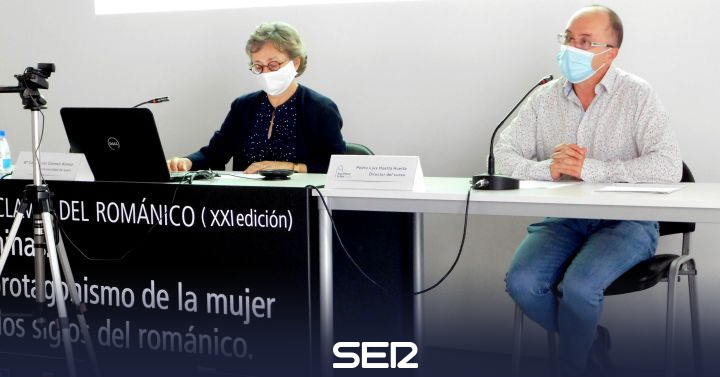What role did women play in the development of the Romanesque? How was it represented in art? These are some of the questions to which the seven experts who participate in a new edition of the course will answer. The Keys of the Romanesque, organized by the Santa María la Real Foundation thanks to the collaboration of Town Hall of the town and the Provincial Council of Palencia.
For the first time, the course combines the face-to-face edition, at the entity’s Aguilarense headquarters, in which 28 students participate; with the online session, to which 53 license plates have been registered. In total 81 people from different parts of the Peninsula or from places like Illinois in the United States or Essex in the United Kingdom.
“We are very satisfied with the reception that the online format has had, since it allows us to reach a greater number of people and makes it easier for us to comply with the safety measures and distances in the face-to-face mode”, points out Pedro Luis Huerta, coordinator of the Foundation’s course program, who adds that they will continue to use this combined method in future courses and conferences, since, in addition, “We will record the seven interventions that make up the course and we will make them available to the students, together with the minutes, once the activity is finished, so that they can view them in greater detail ”.
Three days, seven speakers
In both modalities, the attendees, guided by seven expert researchers, will analyze for three days the role of women in medieval society, reeling off the multiple facets of their different fields of action: domestic, public, religious, cultural or work. to get closer to its leading role in the development of Romanesque art, both from the point of view of the promotion and the material execution of the works, without forgetting other aspects related to the forms of representation and their most daily activities.
Queens, infantas and ladies
The session began with the intervention of Diana Pélaz from the University of Santiago de Compostela, who focused on the spaces occupied by medieval women, places, “In which we can find them in an unequivocal way: the house, the convent or the palace” and in which it is verified “That their presence does not speak of ties, but of sociability and interaction that is built beyond its walls”.
A clear example of the bonds that Romanesque women built is for Pélaz, “The medieval courts”, Given the “The queens were made visible before a wide territory through very diverse mechanisms”. They position themselves as benefactors and promoters of monasteries and ecclesiastical foundations, but also “they are in charge of forging ties that run through the cities and towns of the territory that they govern together with their husbands.”
Concha Cosmen of the Institute of Medieval Studies of the University of León has spoken of them, precisely, of queens, infantas and ladies, who has analyzed the artistic patronage exercised by female elites in the Cistercian monasteries of Castilla y León between the 12th and 12th centuries. XIII, pointing out that they came to promote up to 15 abbeys: seven in the Kingdom of León and eight in that of Castile, of which ten were female and eight male.
The representation of women in medieval art
But how were women represented in Romanesque art? The answer will be given during the second day of the course with interventions such as that of José Antonio Olañeta from the University of Barcelona, who will delve into the representation of female donors and promoters in sculpture and painting, investigating their range and motivations, in the various iconographic models that they used or in their differences with respect to the patterns followed by men.
Verónica Abenza, from the Autonomous University of Barcelona, will take over, who will focus on the analysis of female funeral spaces, fixing her gaze on grave goods and tombs to highlight the “Protagonism of women around death”. The day will be closed by Victoriano Nodar from the University of Vigo, who will introduce the participants into the Romanesque imaginary of the Santiago de Compostela cathedral where we find a rich repertoire of female images sculpted in various formats, reliefs, capitals and corbels, with a character marginal and with a catechizing intention.
Of minstrels and embroiderers
The third session will be dedicated to analyzing the role of women in the music and textile production of the moment, with talks by the researcher Josemi Lorenzo and the professor at the Complutense University of Madrid, Laura Rodríguez. Despite the “cultural taboo” that existed around the female voice, since in many cases the learning of writing or polyphony took place in spaces to which they did not have access, “Women made music, composed, directed, taught, interpreted, danced and wrote about it”, says Lorenzo.
The documentation specifically talks about “Singers, minstrels, soldaderas, cantaderas, dancers, laymen … but there are other types of music that, without professional ties, also practiced this art” and, in front of them, the “No music, the noise” of the weeping of the mourners who accompanied the passage of the deceased.
Women also played an important role in textile activity. Embroidery and weaving were tasks in which noble ladies occupied a large part of their time. But in other estates they also dedicated themselves professionally to the performance of different textile tasks, as Laura Rodríguez will explain, who will speak, in addition to how clothing could serve to distinguish the social status of women or their religion.
–

:strip_icc():format(jpeg)/kly-media-production/medias/3271609/original/098768500_1603097869-pexels-anna-shvets-5067957.jpg)
:quality(80)/cdn-kiosk-api.telegraaf.nl/643e169e-1321-11eb-8517-02d2fb1aa1d7.jpg)